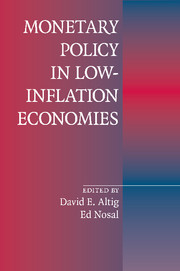Book contents
- Frontmatter
- Contents
- Contributors
- Acknowledgments
- Introduction
- 1 The Welfare Cost of Inflation in the Presence of Inside Money
- Commentary
- 2 An Open-Economy Model of Endogenous Price Flexibility
- Commentary
- 3 Efficient Inflation Targets for Distorted Dynamic Economies
- Commentary
- 4 Inflation and Welfare in Models with Trading Frictions
- Commentary
- 5 Good versus Bad Deflation: Lessons from the Gold Standard Era
- Commentary
- 6 Monetary Policy Orientation in Times of Low Inflation
- Commentary
- 7 Observations on Disinflation in Transition Economies
- Commentary
- 8 Inflation and Financial Market Performance: What Have We Learned in the Last Ten Years?
- Commentary
- Index
Commentary
Published online by Cambridge University Press: 26 January 2010
- Frontmatter
- Contents
- Contributors
- Acknowledgments
- Introduction
- 1 The Welfare Cost of Inflation in the Presence of Inside Money
- Commentary
- 2 An Open-Economy Model of Endogenous Price Flexibility
- Commentary
- 3 Efficient Inflation Targets for Distorted Dynamic Economies
- Commentary
- 4 Inflation and Welfare in Models with Trading Frictions
- Commentary
- 5 Good versus Bad Deflation: Lessons from the Gold Standard Era
- Commentary
- 6 Monetary Policy Orientation in Times of Low Inflation
- Commentary
- 7 Observations on Disinflation in Transition Economies
- Commentary
- 8 Inflation and Financial Market Performance: What Have We Learned in the Last Ten Years?
- Commentary
- Index
Summary
Wachtel and Korhonen's essay provides an overview of the disinflation process in central and eastern Europe and case studies of selected countries. Its main finding is that disinflation is the result of institution building and structural reforms, but it is independent of the exchange rate regime and the monetary policy approach. The authors do not rule out the possibility that global shocks are an important factor for disinflation in transition countries. I broadly share these conclusions. Wachtel and Korhonen also warn that European Union (EU) accession countries cannot achieve both price-level and exchange rate stability during a period of income convergence. I hope this warning will be heard in Europe.
Before I go into some of the issues discussed in the foregoing chapter, let me point out, by way of introduction, that the transition countries are a very diverse group. They differ so widely that their common history over the past few decades is probably the only reason for pooling them in a group. Transition countries share few characteristics that might distinguish them clearly from other countries. Their cultural traditions differ considerably. At one end of the spectrum covered by the transition countries, we find a number of famous harbor towns in the Hanseatic League and at the other end the greatest oases on the Silk Road. In the richest transition country, gross domestic product per capita at purchasing power parity started out 20 times higher than in the poorest, with the differential widening during transition.
- Type
- Chapter
- Information
- Monetary Policy in Low-Inflation Economies , pp. 254 - 258Publisher: Cambridge University PressPrint publication year: 2009



